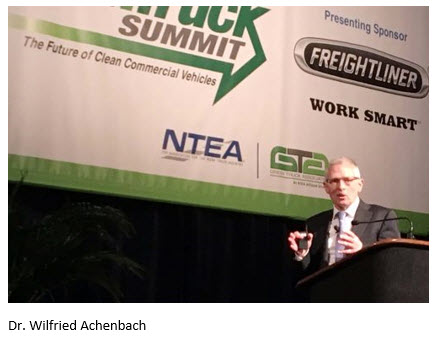
DTNA’s Achenbach: ’10 miles per gallon will become the new normal’
Dr. Wilfried Achenbach was a featured speaker at the Green Truck Summit in Indianapolis recently.
Diesel prices at their lowest point in more than a decade have hindered wide adaptation of alternative fuels, but historical volatility in the market underpins the transportation industry’s efforts.
“In 2007, we had $60 per barrel oil,” says Mark Howerton, manager of national accounts, vocational sales for Daimler Trucks North America (DTNA), “before jumping to $140 per barrel in 2008.”
Three years ago, oil crashed to $40 per barrel and diesel prices have floated below $3 per gallon ever since.
“We have to be prepared for change,” Howerton says, adding alternative fuels, including electrification, are still a viable solution to dependence on foreign oils.
“We still see robust interest in natural gas vehicles in our customer base,” he says. “[But] true long haul transportation will be dominated by clean diesel.”
“Our workhorse is the diesel engine,” adds Dr. Wilfried Achenbach, DTNA senior vice president of engineering and technology.
Both Howerton and Achenbach were featured speakers at the Green Truck Summit in Indianapolis Tuesday (March 14th.)
With diesel’s high energy density and wide availability, its largest drawbacks Achenbach says are basically the fuel’s emissions.
Over the last nearly 30 years, the amount of pollutants spewing from a truck’s exhaust has been slashed. Achenbach says one truck from 1988 emits as much NOx as 35 EPA 2010 trucks, and 60 trucks worth of particulate matter.
However, trucks contribute 6 percent of the CO2 emissions in the U.S., with 75 percent of that coming from long haul trucks.
Green House Gas Phase 2 regulations passed last year target a 25 percent efficiency improvement by 2027, which Achenbach says will lead to fuel economy in excess of 10 – or even 11 – miles per gallon.
“In the future, 10 miles per gallon will become the new normal,” he says, “and I don’t think we need to wait the 10 years. I believe it will happen much sooner.”
To reach efficiency targets, truck and trailer OEMs will be challenged to improve in many areas not necessarily related to power generation.
According to Achenbach, a truck needs 170 hp to power a 76,000 pound load to 62 mph on a straightaway. Aerodynamic drag takes up about 85 hp and rolling resistance takes up 74. Losses from the drivetrain eat up about 6 hp and auxiliary losses take the remaining 5.
Unlike previous GHG regulations, which mostly sought to reduce emissions to near-zero levels, Phase 2 looks to improve the efficiency of the combination unit and changing propulsion methods to a “cleaner burning” source isn’t the low-hanging fruit many people believe it to be.
“It doesn’t make any sense to go to electricity,” Achenbach says, noting the coal used to generate the electric power needed to charge a truck’s battery bank.
Green energy aside, while both the cost and weight associated with batteries have fallen, they’re still not comparable with diesel. For 600 miles of driving, a truck would need a battery pack weighing 11,022 lbs. that costs $156,239. Compare that to a diesel tank that weighs 840 lbs. and cost $1,162.
“Many people investigate what can be done, what is reasonable, but there is no simple answer,” Achenbach says. “Do not discount diesel, and I would recommend to have a close look at renewable [fuel].”
Autonomy could also lead to some measurable efficiency improvements, but Achenbach says he’s not bullish on fully autonomous trucks in the near future. He says significant infrastructure improvements are still needed, including vehicle-to-vehicle communications, better mapping and higher resolution GPS data that would maximize safety for fully autonomous trucks.
“We all need to accept that at some time, we will have mixed traffic [human and autonomous],” he says. “We are on a path to more autonomous, but it will not be a revolution. It will be more evolution. Partial autonomous is feasible. Fully autonomous, I foresee a significantly longer timeline.”
This article is part of Daily Market News & Insights
Tagged: Achenbach, DTNA, Green Truck Summit
MARKET CONDITION REPORT - DISCLAIMER
The information contained herein is derived from sources believed to be reliable; however, this information is not guaranteed as to its accuracy or completeness. Furthermore, no responsibility is assumed for use of this material and no express or implied warranties or guarantees are made. This material and any view or comment expressed herein are provided for informational purposes only and should not be construed in any way as an inducement or recommendation to buy or sell products, commodity futures or options contracts.







